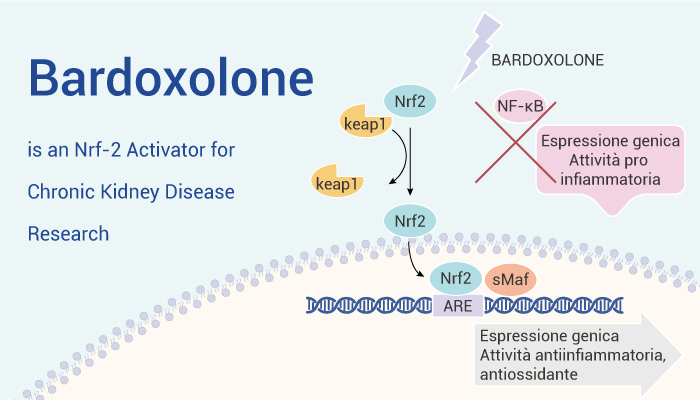Keap1-Nrf2 is the major regulator of cytoprotective responses to electrophilic chemicals or reactive oxygen species (ROS). Keap1 is an E3 ligase, which induces the degradation of Nrf2 by ubiquitin-proteasome system (UPS). Upregulation of Nrf2 inducing by inactivation of Keap1 is often observed in cancer cells. Aberrant activation of Nrf2 in cancer cells accelerates proliferation and metabolism. For this case, Nrf2 is an attractive molecule as a therapeutic target in cancer. Therefore, a lot number of Nrf2 inhibitors are developed. What’s interesting, Nrf2 induction is also reported to be treatment strategies for accelerating the detoxification of carcinogens and protect the body from chemical carcinogenesis.
Diabetic nephropathy (also known as diabetic kidney disease) is the chronic loss of kidney function occurring in those with diabetes mellitus. And it is the leading causes of chronic kidney disease (CKD) and end-stage renal disease (ESRD) globally. The triad of protein leaking into the urine (proteinuria or albuminuria), rising blood pressure with hypertension and then falling renal function is common to many forms of CKD. Protein loss in the urine due to damage of the glomeruli may become massive, and cause a low serum albumin with resulting generalized body swelling (edema) so called nephrotic syndrome. And it usually is slowly progressive over years.
Bardoxolone is a Nrf-2 Activator for Chronic Kidney Disease Research
Bardoxolone is a novel nuclear regulator factor (Nrf-2) activator and can be used in chronic kidney disease research. In vitro, Bardoxolone inhibits SARS-CoV-2 replication in Vero cells with an EC50 value of 0.43 μM. And it also inhibits SARS-CoV-2 viral replication in human Calu-3 cells with an EC50 value of 0.42 μM.
In conclusion, Bardoxolone is a novel Nrf-2 activator for chronic kidney disease research.
References:
[1] Signal Transduct Target Ther. 2021 May 29;6(1):212.
